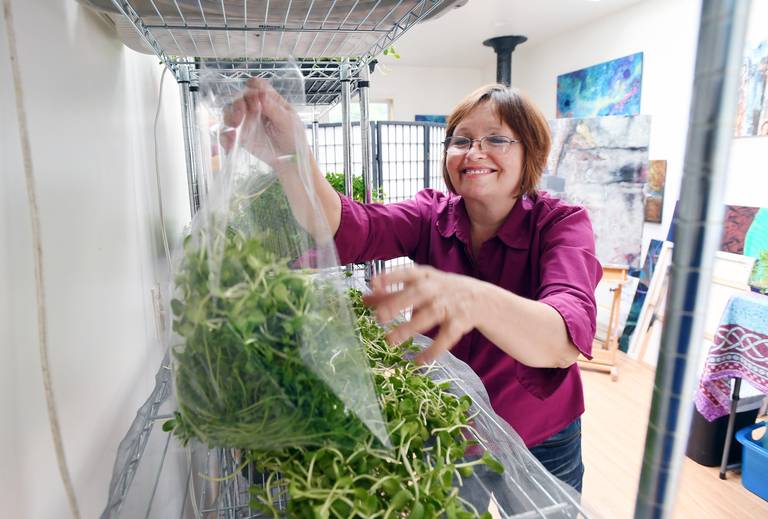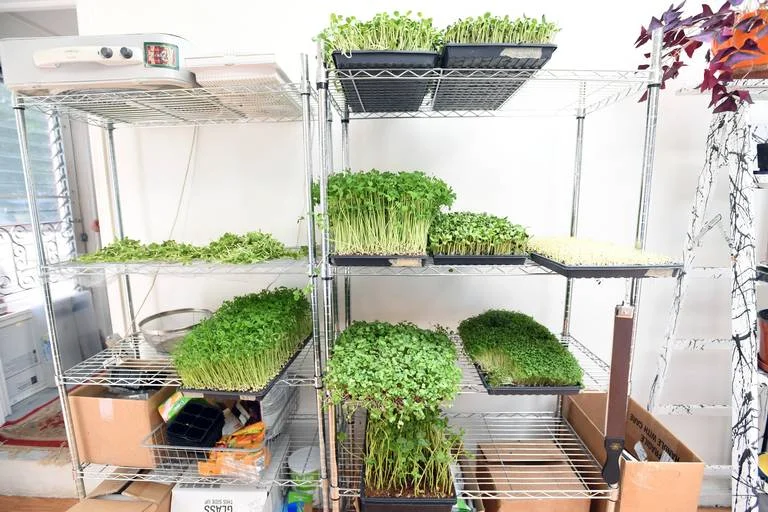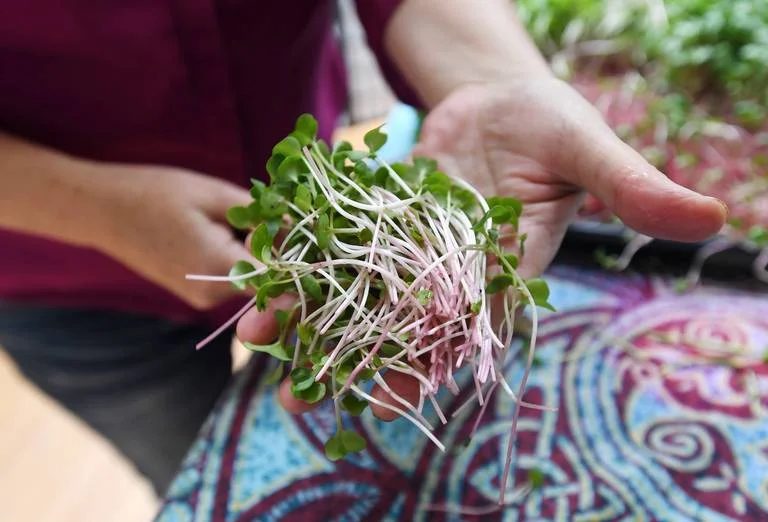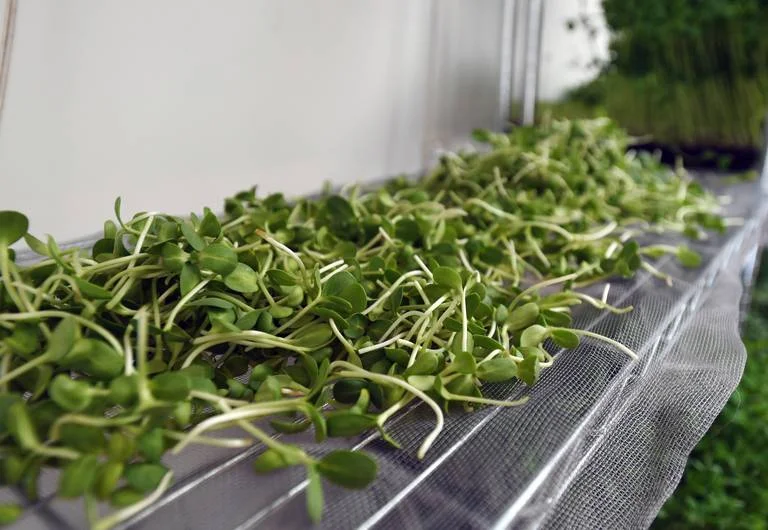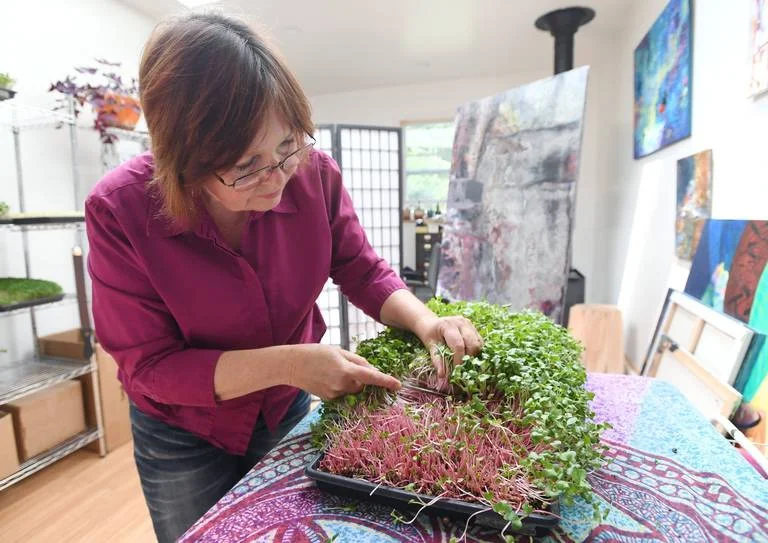Tiny In Size, Giant In Nutrients: Microgreens Make A Mark In State College
Happy Valley Greens owner Isabel Kumerz talks about the various kinds of microgreens she grows at her home in State College. Phoebe Sheehan
Tiny In Size, Giant In Nutrients: Microgreens Make A Mark In State College
BY HOLLY RIDDLE June 06, 2018
Isabel Kumerz grew up in Spain with dreams of one day growing her own food. When she moved to State College and the ample space allowed her to garden, she did so voraciously. However, when the barren winters of central Pennsylvania hit, she started looking for ways to continue her passion year-round, researching greenhouses and other options before finally discovering the world of microgreens.
Greens that are harvested after the sprout stage and before reaching the baby greens stage, microgreens are prized for their potent flavors, attractive appearance, and high nutrient density. In fact, microgreens are considered a superfood, with four to 40 times more nutrients than are in a fully developed plant. They’re also known for being relatively easy to grow, even in urban settings.
“Microgreens gave me the opportunity to grow vegetables all year-round, almost every week, indoors,” Kumerz said. “Microgreens, in my opinion, are an amazing crop ... they’re tiny, they have a lot of nutrients, they’re really beneficial for your health and delicious. They grow very fast, in 7-12 days. They’re very easy to grow (and) don’t need much ... only soil and water.”
Last year, Kumerz turned her newfound love of growing microgreens into a business. Happy Valley Greens opened for orders in September and microgreens are available for purchase online and at Nature’s Pantry, McLanahan’s Downtown Market and Friends & Farmers Online Market.
With a background in graphic design, Kumerz said she never expected to become a farmer, but as the business has taken up more and more of her time, she’s accepted the change wholeheartedly.
“Before, I had a graphic design company, but this business is completely different. It connects you to Mother Earth and also to your community in a really beautiful way," she said. "As an artist, I still teach and paint and do some exhibitions now and then, but the microgreens are taking almost all my time now. You have to plant every week and harvest every week.”
The vertical farming operation is located just a short walk from downtown State College and Kumerz uses all non-GMO seeds and organic soil to ensure quality.
Her next step is to begin providing local restaurants and chefs with microgreens, hoping the availability of her fresh greens even in the winter months will be a selling point for regional venues. Since once harvested, the greens are very susceptible to heat and sun (which is why you won’t find this farmer at a traditional farmers market), Kumerz plans to use hydroponic mats to deliver the microgreens to restaurants still alive and thriving, available to harvest on an as-needed basis. Currently, most of the microgreens are harvested the same day they’re delivered.
Happy Valley Greens offers six types of microgreens, including sunflower shoots, radish greens, bread and butter greens, wasabi mustard greens, pea shoots and a chef’s blend of several varieties. Kumerz is open to expanding her offerings along with consumer demand and expects when she begins pitching her products to restaurants, chefs may have different preferences than average consumers. Her favorite, and the best-seller is the sunflower shoots.
In her own kitchen, Kumerz's favorite ways to use the microgreens include adding them into frittatas, stir-fries and salads, or using them as garnish.
“Everything you cook, you put a little microgreens on top — it looks gorgeous!” she said. “It’s not only beautiful but it (adds) vitamins and nutrients.”
To try Happy Valley Greens for yourself, beyond making a purchase at McLanahan’s, Nature’s Pantry or Friends & Farmers Online Market, you can place an order on the Happy Valley Greens website, happyvalleygreens.com. Then, pick up your microgreens order right at the source, with pickups scheduled on harvest days for optimum freshness.
Holly Riddle is a freelance food, travel and lifestyle writer. She can be reached at holly.ridd@gmail.com.


